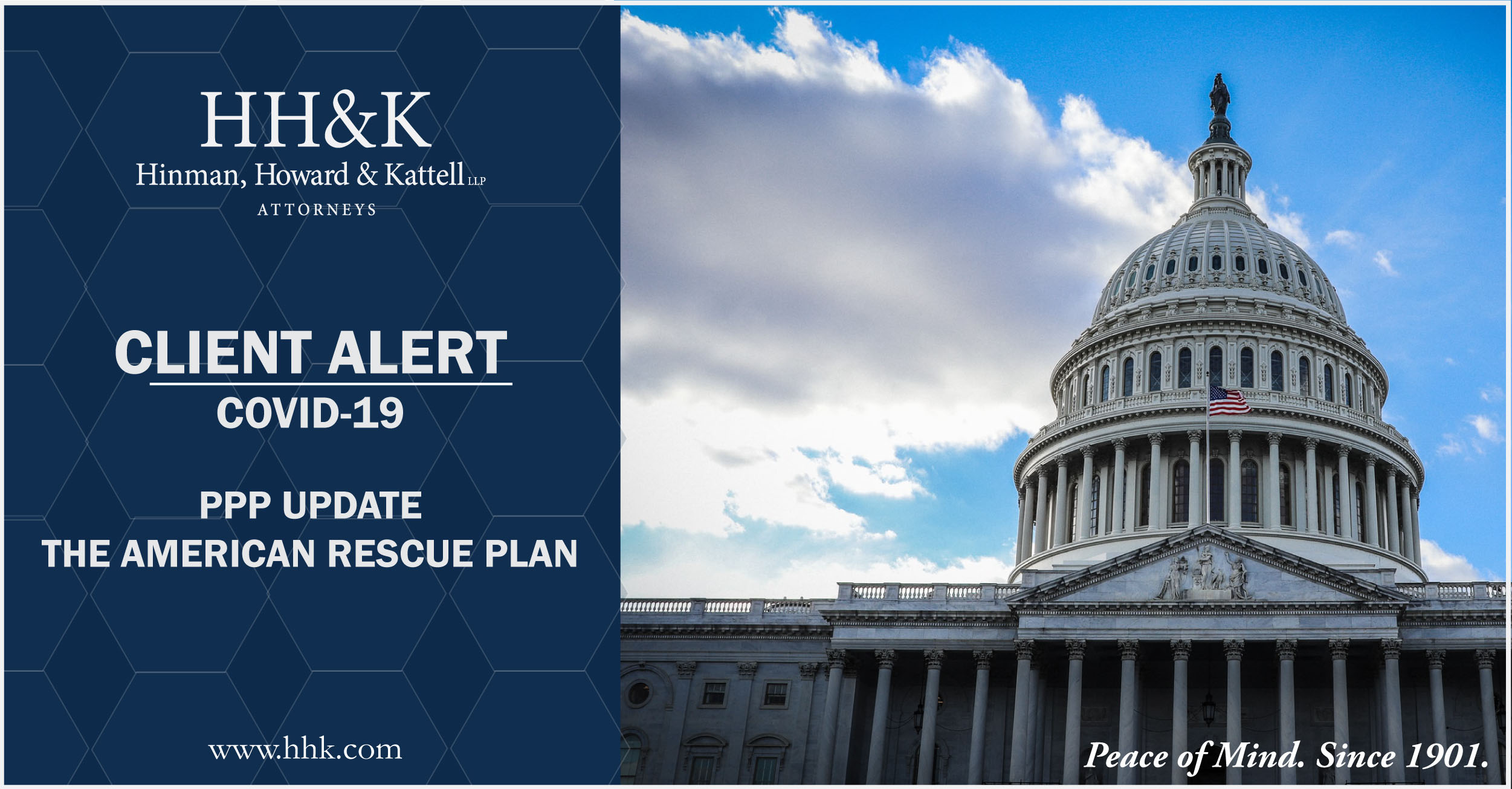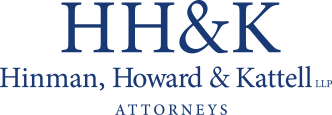Client Alert | Business | PPP – The American Rescue Plan

Updated: April 2, 2021
Earlier this week, President Biden signed the PPP Extension Act of 2021 into law. The PPP Extension Act extends the deadline to apply for a PPP loan to May 31, 2021 and gives the Small Business Administration an additional 30 days beyond that (i.e. to June 30, 2021) to process PPP loans. The Paycheck Protection Program was previously set to expire on March 31, 2021 and this new act gives any eligible applicants that have not yet received a First Draw or Second Draw PPP loan an additional two months to apply for one. For more information on the American Rescue Plan, please see our March alert below.
Original Client Alert: March 18, 2021
Dear Clients and Friends:
President Biden signed The American Rescue Plan, a $1.9 Trillion coronavirus relief bill, into law on Thursday, March 11, 2021. This new stimulus package not only provides direct payments to individuals within certain income thresholds, but it also provides more much-needed aid to small businesses that have been impacted by the COVID-19 Pandemic. The American Rescue Plan, inter alia, (1) appropriates $28.6 billion for a new grant program for restaurants, bars and other food and beverage businesses that experienced a loss of revenue in 2020 as a result of COVID-19; (2) appropriates additional funds to the Paycheck Protection Program (the “PPP”) and the Shuttered Venue Operator Grant (“SVO Grant”) program and makes some changes to both of those programs; and (3) appropriates additional funds for the Economic Injury Disaster Loan (“EIDL”) advance programs.
This Client Alert provides a general summary of the provisions of The American Rescue Plan related to certain small business programs. This information is not legal advice and may not be suitable for all client situations. As always, if you would like specific legal assistance with respect to these programs or any other matters, please do not hesitate to contact your HH&K attorney.
Relief for Restaurants
The American Rescue Plan establishes a $28.6 Billion Restaurant Revitalization Fund to be administered by the Small Business Association (“SBA”) to provide economic aid to hard-hit businesses in the food and beverage industry in the form of grants (“Restaurant Revitalization Grants”).
Eligible Businesses
Businesses eligible to receive a Restaurant Revitalization Grant include restaurants, food stands, food trucks, food carts, caterers, saloons, inns, taverns, bars, lounges, brewpubs, tasting rooms, taprooms, and other similar places of business in which the public or patrons assemble for the primary purpose of being served food or drink. There are, however, some limitations. The following businesses are not eligible for Restaurant Revitalization Grants: (1) businesses that, together with any affiliated businesses, own or operate more than 20 locations (regardless of whether those locations do business under the same or multiple names); (2) government operated businesses; and (3) publicly traded companies.
Notably, Restaurant Revitalization Grants are available to eligible businesses that have received PPP loans (including both first draw PPP loans and second draw PPP loans). The amount of the Restaurant Revitalization Grant that an eligible business may obtain will be reduced by the amount of any PPP loans received by the business, but eligible businesses may participate in both programs. Businesses that received or have a pending application for a SVO Grant, however, are not eligible to receive a Restaurant Revitalization Grant. Any business that is eligible for both a SVO Grant and a Restaurant Revitalization Grant must choose between the two programs.
Amount of Grant
Eligible businesses may receive a Restaurant Revitalization Grant in an amount equal to its “pandemic-related revenue loss” up to $10 Million per business (together with all affiliated businesses) and $5 Million per physical location. The “pandemic related revenue loss” for an eligible business will generally be determined by subtracting the business’s 2020 gross receipts from its 2019 gross receipts, subject to modified calculation methodologies for businesses that were not in operation for all of 2019. In addition, if an eligible business received one or more PPP loans, the “pandemic related revenue loss” will be reduced by the amount of any PPP loans received.
Priority in Awarding Grants
Of the $28.6 Billion allocated to the program, during the first sixty (60) days that Restaurant Revitalization Grants are being awarded (or such other period as determined by the SBA): (1) $5 Billion is earmarked specifically for businesses with 2019 gross receipts less than $500,000; and (2) the remaining $23.6 Billion will be awarded in “an equitable manner” to other eligible entities of different sizes based on annual gross receipts. After that initial 60-day period (or such other period that may be determined by the SBA), Restaurant Revitalization Grants can be made to any eligible businesses regardless of its annual gross receipts. In addition, for the first 21 days of the program, the SBA will prioritize establishments owned by women, veterans, or economically and socially disadvantaged groups. Beyond that, grants will be awarded in the order received until all funds are expended.
Use of Funds
Recipients of Restaurant Revitalization Grants may use the money for the following expenses incurred during the covered period (which runs from February 15, 2020 through December 31, 2021) as a direct result of, or during, the COVID-19 pandemic:
- Payroll costs;
- Payments of principal or interest on any mortgage obligation (pre-payment is not allowed);
- Rent payments, including rent under a lease agreement (pre-payment is not allowed);
- Utilities;
- Maintenance expenses, including construction to accommodate outdoor seating and walls, floors, desk surfaces, furniture, fixtures, and equipment;
- Supplies, including protective equipment and cleaning materials;
- Food and beverage expenses that are within the scope of normal business practice of the entity before the covered period;
- Covered supplier costs for purchase of goods essential to business operations made pursuant to certain types of contracts/purchase orders;
- Operational expenses;
- Paid sick leave; and
- Any other expenses that the SBA determines to be essential to maintaining the business.
If an eligible business that receives a Restaurant Revitalization Grant fails to use all grant funds for permissible expenses or permanently ceases operations on or before the last day of the covered period, the business must return the unused funds.
Need Certification
As with other similar government programs related to the coronavirus pandemic, businesses applying for Restaurant Revitalization Grants will be required to certify in good faith that the uncertainty of current economic conditions makes the grant request necessary to support ongoing operations of the business.
Restaurant Revitalization Grants Not Taxable
Similar to SVO Grants and PPP loans, Restaurant Revitalization Grant recipients will not be taxed on any grant amounts received, nor will the deductibility of any expenses that are otherwise deductible under the Internal Revenue Code be impacted by the receipt of a Restaurant Revitalization Grant.
Changes to the PPP and SVO Grant Program
The American Rescue Plan allocates an additional $7.25 Billion to the PPP, but does not extend the program beyond its current March 31, 2021 expiration date. This new legislation also expands eligibility for PPP loans to certain internet-only news and periodical publishers and additional types of 501(c) non-profit entities that were not previously eligible, provided that those non-profit entities (a) have 300 or fewer employees and (b) meet specified limitations regarding lobbying activities.
When the SVO Grant program was established in the Economic Aid to Hard-Hit Small Businesses, Non-Profits and Venues Act that was passed on December 27, 2020, businesses could not receive both a PPP loan and an SVO Grant after December 27, 2020. That has now changed. The American Rescue Plan (a) allocates an additional $1.25 Billion to the SVO Grant program and (b) allows eligible businesses to participate in both the PPP and SVO Grant programs. Under the new rules, the amount of any PPP loan received on or after December 27, 2020 will reduce the amount of the SVO Grant that a business is otherwise eligible for, but businesses no longer have to choose between the PPP and the SVO Grant program.
PLEASE NOTE: As the PPP has not been extended beyond March 31, 2021, any businesses that are looking to apply for a first draw or second draw PPP loan should reach out to an eligible lender now. It is likely that lenders will stop accepting PPP applications in advance of the March 31 deadline so that there is sufficient time to process the application and receive the required SBA guarantee on or before that date.
Targeted EIDL Advance
The CARES Act included a program allowing eligible businesses to apply for and receive EIDL “advances” that were, in effect, grants that did not have to be repaid. The Economic Aid to Hard-Hit Small Businesses, Non-Profits and Venues Act appropriated additional funds for EIDL advances targeted to companies within low-income communities that were especially hard hit by the pandemic (“Targeted EIDL Advances”). The American Rescue Plan appropriates an additional $10 Billion for the Targeted EIDL Advance program established by the Economic Aid to Hard-Hit Small Businesses, Non-Profits and Venues Act.
The Targeted EIDL Advance program, as implemented by the SBA, does not require eligible recipients to take any action unless and until they are contacted by the SBA. The SBA announced that it is reviewing applications previously submitted for EIDL advances under the CARES Act to try and identify applicants that may be eligible for a Targeted EIDL Advance and would be contacting applicants that either (1) previously received an EIDL advance for less than $10,000; or (2) applied for an EIDL advance but received no funds due to lack of available program funding.
The American Rescue Plan also appropriates an additional $5 Billion to provide new EIDL advances to eligible businesses that have suffered an economic loss of greater than 50% and employ not more than 10 employees. Eligible businesses may receive a one-time $5,000 advance, which, if applicable, shall be in addition to any other EIDL advances received under the CARES Act or the Economic Aid to Hard-Hit Small Businesses, Non-Profits and Venues Act. It is not yet clear whether the SBA will be accepting new applications for these advances or if it will be reaching out to potentially eligible businesses as it is doing for the Targeted EIDL Advance program.
As with PPP loans, SVO Grants and Restaurant Revitalization Grants, any amounts received under the EIDL advance program (targeted or otherwise) are not taxable and will not impact the deductibility of expenses that are otherwise deductible under the Internal Revenue Code.
Contact Your HH&K Attorney for Legal Guidance
This information is not legal advice and may not be suitable for all client situations. This Client Alert provides general information regarding The American Rescue Plan and certain small business programs associated therewith and does not outline all of the important considerations related thereto. We anticipate that the terms of each of these programs may continue to evolve as the SBA releases guidance.
This Client Alert is not a substitute for legal guidance regarding program details and how those may be applicable to your business. As always, if we can be of assistance with these programs or any other matters, please do not hesitate to contact your HH&K attorney.
Click here for the updated printable version of this Client Alert.
Copyright © 2021 by Hinman, Howard & Kattell LLP. This Client Alert is provided as a general information service to clients and friends of Hinman, Howard & Kattell, LLP. It should not be construed as, and does not constitute legal advice on any specific matter, nor does this message create an attorney-client relationship. These materials may be considered Attorney Advertising in some states.

